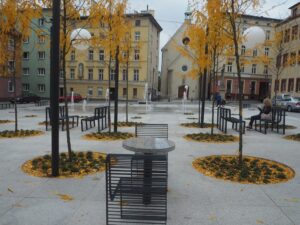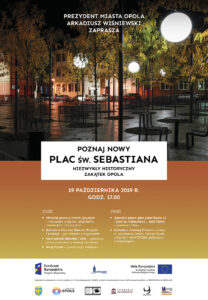 The development of the city of Opole on the right bank of the Oder River began as early as the 12th century. In 1217 Duke Casimir I granted the city rights (under the Flemish law). In 1327, they were supplemented according to the Środa law (a variety of the Magdeburg law). The medieval settlement in the 12th and 13th centuries was given an urban shape. At the end of the 13th century Prince Boleslaw I of Opole surrounded the city with a defensive wall with a moat, 5 gates and towers. The urban layout of the city, i.e. the market square, the grid of streets and squares at defensive walls made Opole a special trade and administrative center. The buildings of the 15th century square, just like the entire town, were wooden.
The development of the city of Opole on the right bank of the Oder River began as early as the 12th century. In 1217 Duke Casimir I granted the city rights (under the Flemish law). In 1327, they were supplemented according to the Środa law (a variety of the Magdeburg law). The medieval settlement in the 12th and 13th centuries was given an urban shape. At the end of the 13th century Prince Boleslaw I of Opole surrounded the city with a defensive wall with a moat, 5 gates and towers. The urban layout of the city, i.e. the market square, the grid of streets and squares at defensive walls made Opole a special trade and administrative center. The buildings of the 15th century square, just like the entire town, were wooden.
In 1615 a great fire consumed most of the wooden buildings of the town. Before the inhabitants rebuilt their homes, the town was once again destroyed during the Thirty Years’ War. St. Sebastian’s Square, located in the northeastern part of the old town, was created in its present form, only after the fires and wars that took place in the 17th and 18th centuries.
A tavern was located on St. Sebastian’s Square most probably already in the middle of the 17th century. It was located directly at the city walls, near the Mikołajska and Gosławicka gates. It was probably built of wood on a stone foundation, and according to F. Idzikowski’s account, it also had stone cellars for storing goods. In the spring of 1679 a foreigner suffering from the plague died in this inn. The plague spread quickly, and caused the death of around 900 people by the end of 1680, i.e. almost half of the inhabitants of Opole at that time. It happened that the people living on the opposite bank of the Oder River demolished the bridge to prevent the plague from reaching them. In 1680 the inn building was demolished and replaced by a votive chapel of St. Sebastian – the patron saint of infectious diseases and advocate at the time of the epidemic. The people of Opole worshiped St. Sebastian on 20 January, and St. Roch on 16 August – patron saints protecting against pests and infectious diseases. Solemn processions were held in the city on those days.
 Two thirds of the town’s buildings burnt down in another big fire in 1739. Apart from residential houses, the town hall, monastery buildings, farm and production buildings, e.g. breweries, mills and numerous craftsmen’s workshops, the entire wooden building of St. Sebastian’s Square, then called „Freier Platz”, also burnt down as well. After this tragedy, the wreckage around the square was cleaned up and the remains of the burnt houses were demolished, and the square was then shaped in a similar way to the present one. Before the houses were rebuilt, it was the place of trading pots and cattle markets.
Two thirds of the town’s buildings burnt down in another big fire in 1739. Apart from residential houses, the town hall, monastery buildings, farm and production buildings, e.g. breweries, mills and numerous craftsmen’s workshops, the entire wooden building of St. Sebastian’s Square, then called „Freier Platz”, also burnt down as well. After this tragedy, the wreckage around the square was cleaned up and the remains of the burnt houses were demolished, and the square was then shaped in a similar way to the present one. Before the houses were rebuilt, it was the place of trading pots and cattle markets.
The contemporary buildings on the square date back to the late 19th and early 20th centuries. The present-day tenement houses were probably built on the relics of the old buildings. In 1932 St. Sebastian’s Church was rebuilt. The surroundings of the square and its function changed significantly after 1819, when the demolition of the city’s defensive walls began. Then St. Sebastian’s Square changed from a trade area to a recreation area. At present it has a new architectural style, although the recreational function has been preserved.
W sobotę, 19 października 2019 r. o godz. 17.00 zapraszamy serdecznie na plac św. Sebastiana na warsztaty językowe. Będziemy mówić o historii placu w różnych językach. To będzie prawdziwy Dzień Języków! Zapraszamy! Wstęp wolny!
Wydarzenie realizowane w ramach projektu pn. Przebudowa placów miejskich w Opolu, który Fundacja „Dla Dziedzictwa” realizuje w partnerstwie z Miastem Opole w ramach umowy o dofinansowanie projektu nr RPOP.05.03.01-16-0037/16-00.


